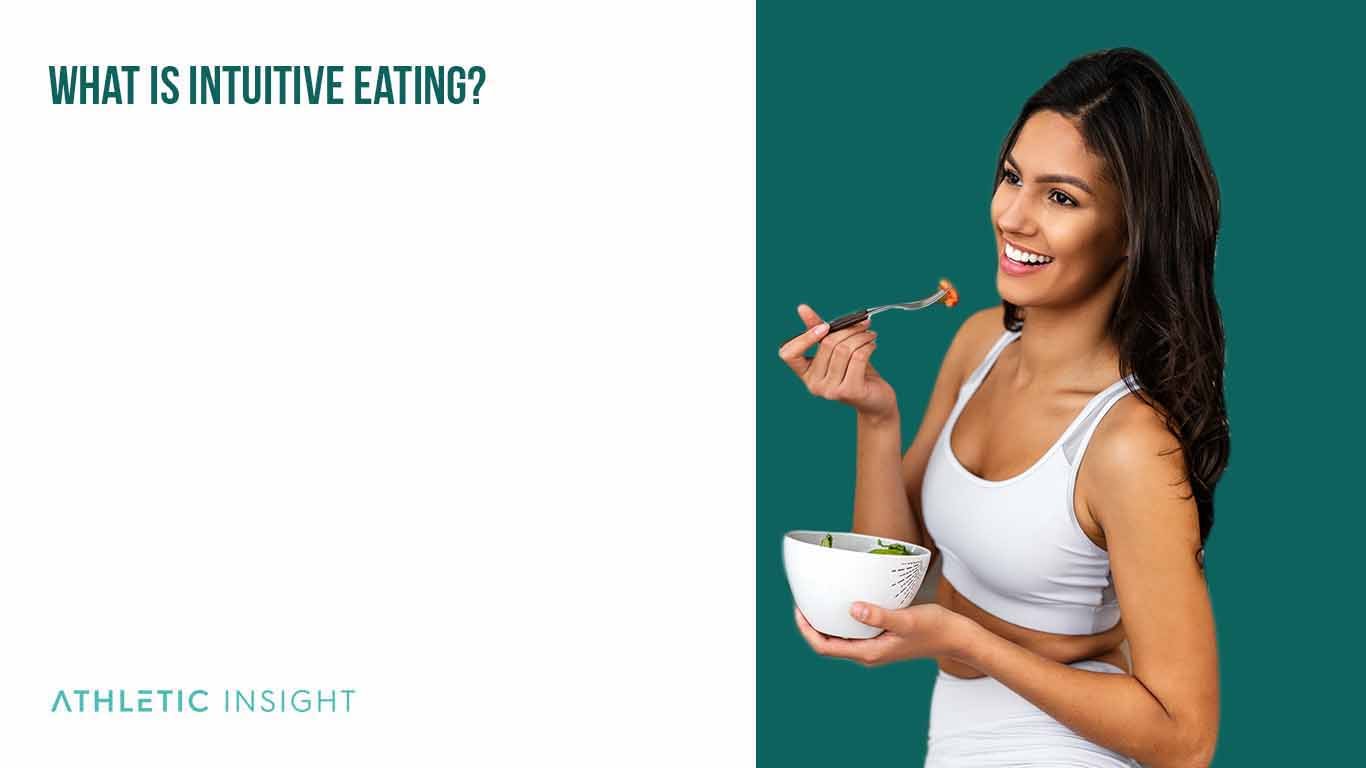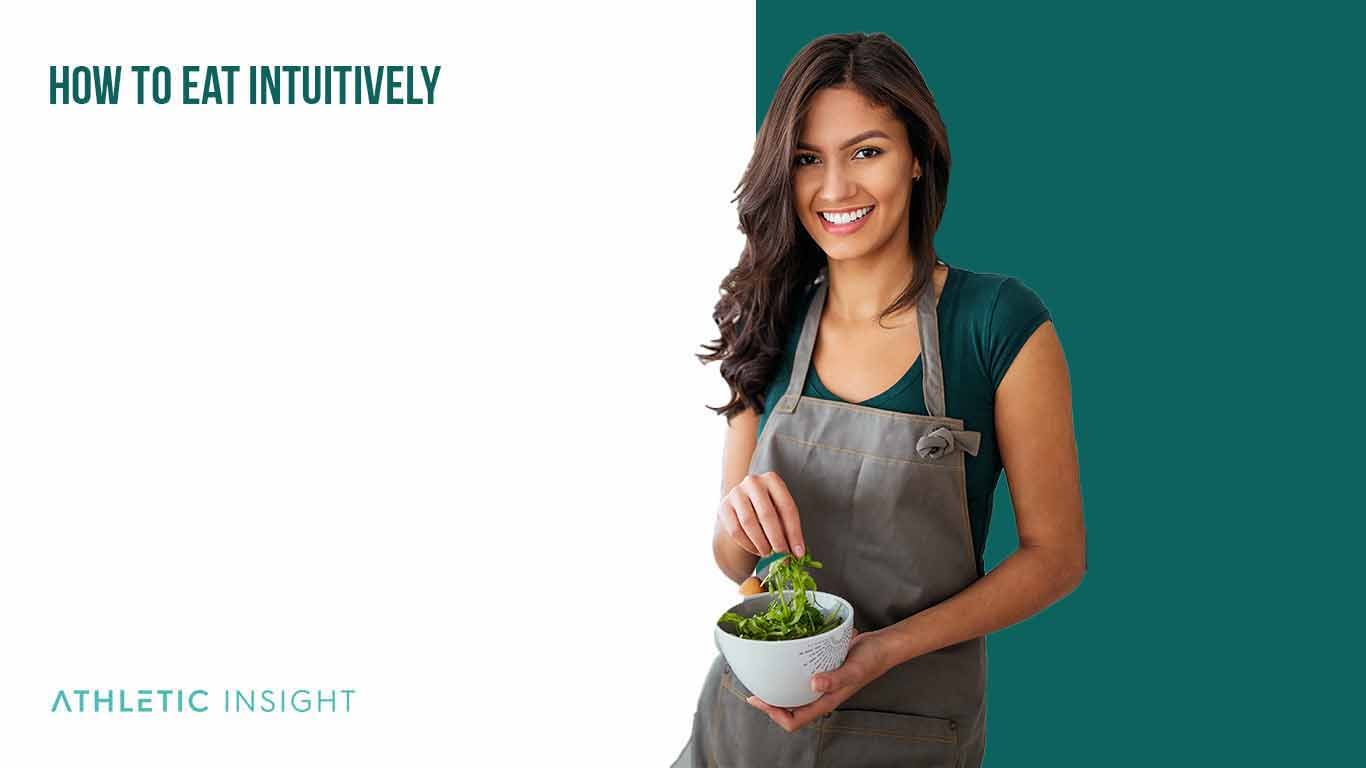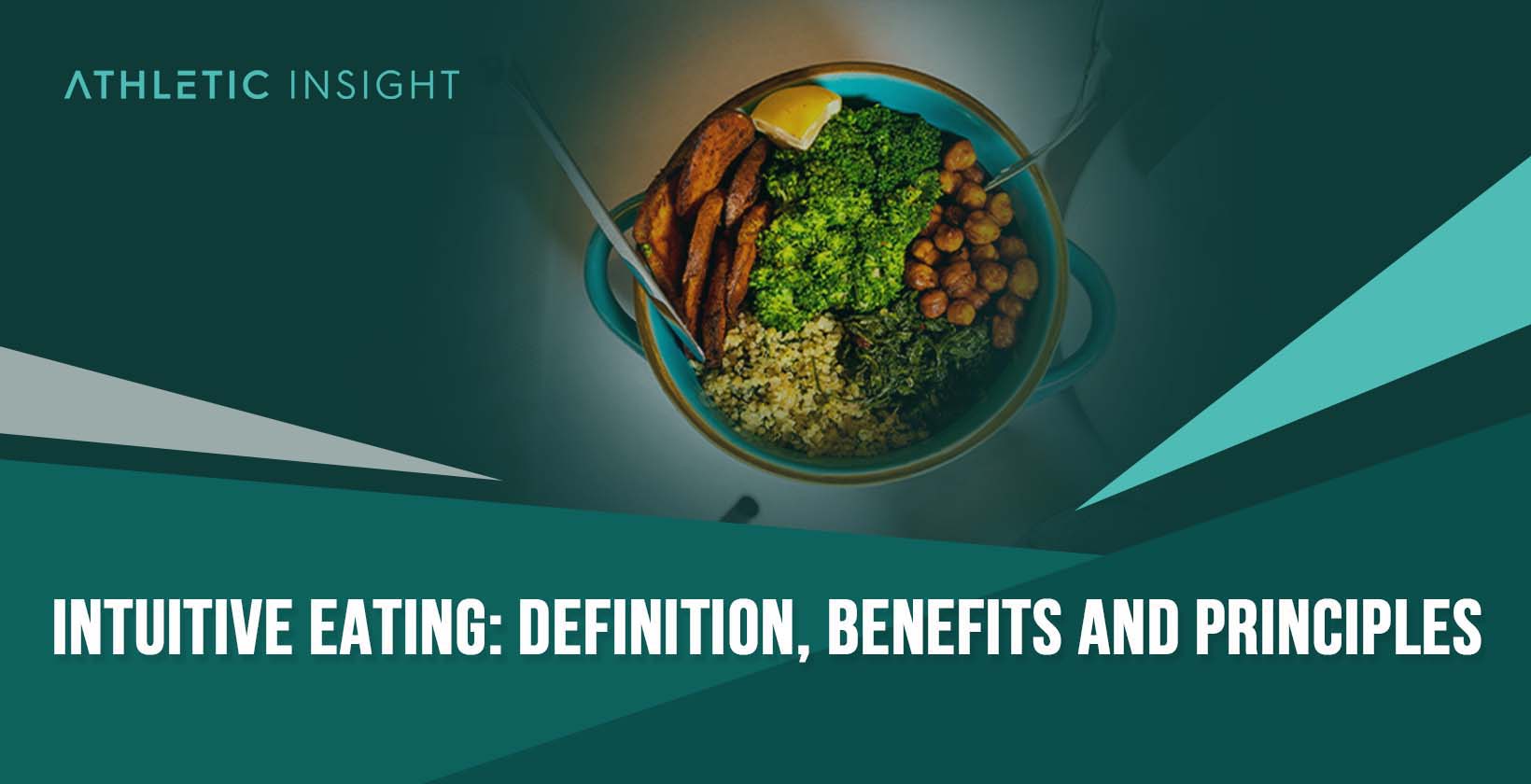Intuitive eating promotes a harmonious relationship with food, steering away from the traditional dieting approach that often involves restricting specific foods and categorizing them as good or bad. This method encourages individuals to listen to their bodies, eating what feels right and recognizing the body’s cues for satiety.
In contrast to diets that impose strict calorie limits, intuitive eating focuses on self-awareness and embracing the body’s innate wisdom to guide food choices without judgment. This approach not only fosters a healthier relationship with food but also supports physical well-being by acknowledging and respecting the body’s natural hunger signals and nutritional needs.
What is Intuitive Eating?
So what is intuitive eating? Intuitive eating is a framework that focuses on self-care and respecting your body as you break barriers related to dieting and unrealistic standards of beauty.

Created by dietitians Elyse Resch and Evelyn Tribole in 1995, this evidence-based model has a validated assessment scale to gauge its efficacy.
Intuitive eating is a very effective method that regulates emotions and instincts by helping a person develop a healthier relationship with food.
Informative intuitive eating books include Evelyn Tribole’s best-seller, “Intuitive Eating, 4th Edition” This book teaches people how to reject the diet mentality.
Tribole also has another book, “The Intuitive Eating Workbook,” which explains the foundation of the diet and how to start changing the way you view food.
These intuitive eating products from Evelyn Tribole and Elyse Reach are useful during your journey of self-discovery.
There are many other resources available, including recipe books, podcasts, and guides. These resources make the convenient diet even easier by allowing you to gradually change your mentality around your food choices.
Rules of Intuitive Eating
Follow these rules to get the most out of the intuitive eating approach.
- Reject diets
- Eat whenever you get hungry
- Take note of when you’re full
- Eat what feels good to eat
- Practice moderation
- Focus on your emotions
Evelyn Tribole and Elyse Resch coined the term intuitive eating in 1995, but it has been around since 1978. Geneen Roth and Susie Orbach have been writing about emotional eating and not restricting food choices since 1978.
Before that, Thelma Wayler created a weight management program in 1973 in Vermont. She declared that diets were ineffective and that personal care and lifestyle changes were vital to healthy living.
Intuitive eating is simple and effective so long as you fully commit to the approach. It takes effort to unlearn what you’ve learned and recommit yourself to respecting and appreciating your body.
It doesn’t cost anything to become an intuitive eater unless you participate in workshops, classes, or individual coaching sessions that range from $200 to $399. To receive the intuitive eating certification as an instructor cost between $1,235-$1,500.
Intuitive eating works by helping you acknowledge your body’s signals for when you’re hungry, full, and satisfied. This is interoceptive awareness. This awareness breaks down barriers that cause negative thoughts toward food and your body.
How Does Intuitive Eating Work?
To start intuitive eating, you need to align your goals with the program. You should allow yourself to eat what you like and learn to understand your body’s fullness cues.
There are no intuitive eating injections or intuitive eating drops that let you lose weight or get healthier faster. To get results, you need to put the work in.
You could also join the community as a certified intuitive eating counselor so that you can help someone as they embark on their intuitive eating journey.
If you want to become a community member, you can go to the intuitive eating homepage. At the bottom of the page, it gives you the option to join as a member or log in as a counselor.
Select either button to write your username and password. There are additional resources that you gain access to also once you join.
Blogs, an intuitive eating book, podcasts, workshops, and more are available as support options. Once you join the community, you also get to reach out to others through message boards where you can share the experience. Plus, you can cancel the subscription at any moment by unsubscribing.
It’s a great idea to meal prep when you do intuitive eating. You don’t have any specific food types that you have to eat or avoid, but you can keep certain meals on hand to give you time to try different foods and reduce cooking time.
Recipe options include pantry meals, such as a spring salad with chicken and dressing, pasta salad with tuna and fresh vegetables, tacos, and more. Intuitive eating allows you to eat at home or dine out.
Intuitive Eating versus the 1200 Calorie Diet
On the other hand, the 1,200-calorie diet represents a highly restrictive eating plan, suggesting a minimum intake that is often insufficient for most adults to maintain their weight, leading to potential weight loss benefits for those who are overweight. While adherents might experience a slowing metabolism and various physiological effects over time, some research points to potential health benefits, including reduced disease risks and improved overall health.
However, these findings are not definitive, with factors such as the types of foods consumed playing a significant role in health outcomes. Unlike intuitive eating, the 1,200-calorie diet limits freedom of choice by imposing a strict calorie ceiling.
Intuitive Eating versus the Mindful Eating Diet
Mindful eating, or the mindful eating diet, is an alternative diet that shares similarities with intuitive eating by encouraging the enjoyment of food through full sensory engagement and eating in response to hunger cues, albeit with less emphasis on bodily respect and unrestricted food choice.
What Are the Health Benefits of Intuitive Eating?
There are both physical and emotional benefits of intuitive eating. Here are the three main benefits of intuitive eating.
- A decrease in disordered eating
- Better emotional functioning
- A more positive body image
A trial published in the Journal of Eating Behaviors compares intuitive eating and restrictive diets amongst a large group of women and men. Intuitive eating consistently and uniquely presented results that showed higher confidence levels and fewer bodyweight concerns.
The promising results led researchers to promote the idea of intuitive eating within public health policies as an approach to help prevent eating disorders.
Are There Any Health Risks of Intuitive Eating?
There are no serious health risks associated with intuitive eating principles but certain people may need to avoid adopting this approach.
Intuitive eating may not be the best choice for people with health conditions, such as high blood pressure, diabetes, or heart disease.
Celiacs should be cautious following intuitive eating because of food allergies that present mild to severe health problems.
Those who need to gain weight due to an eating disorder should consider following the advice of a doctor or a registered dietitian.
How to Eat Intuitively
It takes some mental dedication to do away with the idea of restrictive eating. Follow these tips to learn how to eat intuitively without under-consuming or overconsuming. This balance can enable intuitive eating weight loss.

1. No More Diets.
Diet rules like no eating after 6 PM, no carbohydrates, no refined sugars, and no processed foods, create constant stress about your food choices. As healthy as you’re trying to be, it’s counterproductive.
2. Eat Slowly and Thoughtfully.
Chew slowly as you eat. Allow yourself to experience the different flavors and textures of your food. Practice gratefulness for the work that went into creating your food. These are the ways that you will eventually learn your appetite signals.
If it seems overwhelming to think the whole time you’re eating, try it for the first few minutes. It becomes more regular with time. Chewing slowly is also better for digestion.
3. Acknowledge Your Cravings.
You’re less inclined to grab snacks when you eat what crave. Your food should nourish your body and satisfy your cravings simultaneously. Don’t think that eating the stereotypical “healthy” meal is the best route, as it will leave you wanting things like chocolate, chips, and other sweets.
4. Continue to Eat Until You’re Full and Content.
Many people are taught as children to eat until the food is finished. This teaching makes it hard to adopt intuitive eating because it causes you to ignore signals that you’re full. It can take as long as half an hour for your brain to compute that you’ve finished eating.
Eating slowly helps because it gives your brain a chance to catch up with your body. Take a break when you begin feeling full, and see how you feel after about 15 minutes. Intuitive eating books can help you master these techniques.
What are the Principles of Intuitive Eating?
The idea is that you progress through the intuitive eating principles, taking your time to embrace each one and execute it in your daily life. You may or may not follow them in order; it’s not a linear process. Here are the 10 principles of intuitive eating.
1. Get Rid of the Diet Attitude
Diet attitudes and conventional beauty standards are learned behaviors, causing people to associate their happiness with how much weight they lose.
You have to reprogram your mind to understand that it won’t work long-term. Toss out diet cookbooks, unfollow social media personalities that push dieting, and surround yourself with positive messaging for all body sizes.
2. Respect Your Hunger
This principle is significant because this is where diets largely fail. Diets teach that the hungrier you allow yourself to become, the better you’re doing on your diet. However, this strange and unhealthy relationship with eating causes uncontrollable cravings due to calorie restrictions.
The longer you wait, the hungrier you get. Respect your body’s ability to inform you of when you’re hungry and nourish it accordingly.
3. Make Food Your Ally
The more you identify food as bad and disallow yourself from enjoying it, the more you’ll crave that food item. Studies have shown that the brain’s pleasure centers are more engaged when presented with foods that you have deemed untouchable.
Your cravings will continue and lead to poor food choices and overconsumption. It’s best to permit yourself to eat what you want, and you will no longer crave it and binge eat.
4. Take on the Food Cops
It’s high time to stop feeling guilty about what you enjoy eating. Diets deem certain foods as good and bad. Foods shouldn’t have value judgements.
Reject that ideology because it ultimately leads you to believe that you’re good or bad based on what you eat. These rules surrounding food are unreasonable, and you should never feel ashamed about your food choices.
5. Keep Your Fullness in Mind
Food does more than fill us up; it also satisfies us. When you permit yourself to eat the way you want, you will be more satisfied.
People tend to overeat, even when they’re full. Learn to tell when you’re satisfied not stuffed. This technique will prevent you from overeating.
6. Find Out What Food Makes You Happy
To find out what food makes you happy, you have to pay close attention to how they taste, how you digest them, and how much energy they give you.
Paying attention to subtle cues and your emotional reactions will help you learn what foods work for you. Consider how you feel as you eat a meal or snack. Eventually, your intuitive eating hunger scale will kick in, and you’ll get the hang of your fullness cues.
7. Honor Your Feelings Without Using Food
Though we learn never to tie our emotions into eating, it’s a good thing to acknowledge that it’s a common and logical coping mechanism.
Food shouldn’t be your only way of working through difficult emotions. You can unlearn this behavior by practicing self-compassion.
8. Respect Your Body
Everybody has different body shapes and types, and that’s okay. Even if everyone ate the same foods and used the same exercise regimens, their bodies would still look different from one another.
You should respect your body and treat it with dignity instead of scrutiny and judgment.
It may take time for your to love your vessel, but to respect it is a different idea that entails taking care of it and treating it kindly by giving it what it needs.
9. Exercise
Though it seems that exercising is a staple of the diet movement, in general, physical activity is a good thing whether you diet or not. The problem is that people often overexert themselves when exercising.
It becomes more of a burden than something pleasurable. Put less emphasis on how many calories you’re burning and put more thought into enjoying the movements.
10. Honor Your Health
Nutrition is a critical part of intuitive eating, despite the criticism that would have you believe it’s about constant indulgence. The philosophy of gentle nutrition means that you learn to make food choices that will make your mind and body feel their best.
If you skip fruits and vegetables for a meal or a day, it doesn’t mean that your health is in jeopardy. The approach to health focuses on variety and balance with intuitive eating.
What Are the Facts About Intuitive Eating?
Based on the studies, intuitive eaters are less preoccupied with food. They have lower stress levels, and their self-esteem is higher.
While there are many easy diets to follow, intuitive eating is a sustainable lifestyle choice. Intuitive eaters also have better metabolic rates and cholesterol levels.
How Effective is Intuitive Eating for Weight Loss?
Efficacy for the program depends on how you develop your relationship with food and how you begin to respect your body’s instincts. For example, intuitive eating weight loss is not a given, nor should you necessarily pursue it.
It’s about understanding your body and engaging in physical activity while allowing yourself room to enjoy food and life. Your intuitive eating before and after pictures may look the same, but what’s most important is that your mindset has changed.
Certified intuitive eating counselors and intuitive eating podcasts will help you learn how to develop a better body image and decrease rates of emotional eating.
How Easy is Intuitive Eating to Follow?
If you understand the intuitive eating meaning, you know it is a practice. It will take time for your mentality to adjust to the new rules and understand your emotions and body signals.
There might be some feelings that are hard to let go of, but your relationship with food will slowly but surely change.
Keep in mind that your current behaviors didn’t develop overnight, and reconfiguring your mind also takes time. On average, it takes nearly a month for this method of thinking to begin to stick.
What Books Should You Read to Learn About Intuitive Eating?
Here are the top books from reputable nutritionists.
- “Intuitive Eating: A Revolutionary Anti-Diet Approach” By Evelyn Tribole and Elyse Resch
This book outlines the intuitive eating definition and clarifies how it all began. The authors discuss how people would diet successfully for a few weeks and then return to them defeated because the progress was unsustainable.
Since they were in a constant state of denying themselves certain foods, they could not maintain the results they had previously achieved. Their book outlines the science behind intuitive eating.
- “Anti-Diet” By Christy Harrison
Christy exposes the dangers of diet culture as a multibillion-dollar field that benefits from making people feel that they must look a certain way to be happy, healthy, and fulfilled.
- “Intuitive Eating” – A Revolutionary Program that Works By Evelyn Tribole and Elyse Resch
This book teaches you to nurture and respect your body. Become in tune with how your body feels and what your body is telling you it needs.
What Is the Criticism of Intuitive Eating?
The intuitive eating criticism is that the philosophy behind this method of eating suggests that you can’t have a healthy relationship with food if you enforce restrictions and rules.
This method seems risky to many people because it implies that you can eat whatever you choose, even if it’s unhealthy, instead of learning what’s good for your body and what foods you should avoid purely from a health standpoint.
People believe that intuitive eating may lead to unhealthy weight gain or be unsustainable. However, with the right mindset and guidance, you can practice intuitive eating safely.



